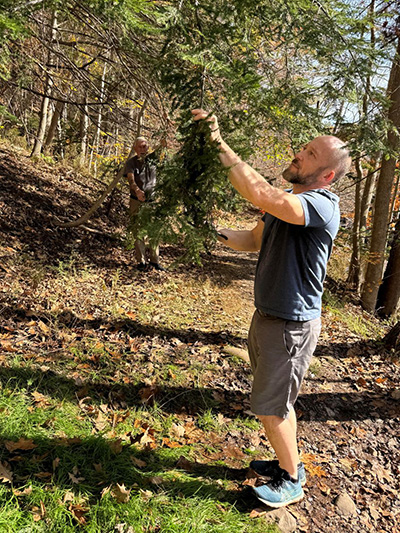At first glance, the Hemlock Woolly Adelgid (HWA) - a tiny, aphid-like insect barely bigger than a millimetre - hardly seems threatening. Beaded among leaves like garland, the insect's fluffy white bodies could be mistaken for the world's smallest cotton balls. You might even say they look cute.
But those who understand the invasive critter and the devastation it can cause know better than to coo over evidence of HWA among nearby trees. Nova Scotia's old-growth hemlock forests, the meal of choice for this insect, are now under significant threat if nothing is done - and the effects of these forests being wiped out would be catastrophic.
Impacts of the HWA invasion and "grey ghost" forests are extensive
Eastern hemlock is a dominant tree species in many forests across Nova Scotia, with significant concentrations in the western regions. Kejimkujik National Park is a notable home to these trees, which are also integral to ecosystems in New Brunswick, Quebec, Ontario, and much of the eastern US.
The first evidence of HWA in Nova Scotia emerged in 2017. With no natural predators and increasingly favourable weather due to climate change, HWA has devastated other parts of North America, leaving "grey ghosts" in place of thriving ecosystems.
Dr. Kirk Hillier, a biology professor at Acadia University, is part of a team of researchers raising the alarm on this issue.
"It's not just a change in the landscape that's at risk - but cascading ecological and economic destruction when entire tree species are lost," said Dr. Hillier. "Old-growth hemlock are known for their dense canopies, which provide shade, regulate water systems, and support diverse wildlife."
"Without these trees, we would see significant impacts on forest biodiversity and community change, as well as increased soil erosion, all of which present significant environmental, economic, and human threats."
Hemlocks also enhance air quality and sequester carbon. If HWA continue to spread and kill trees, these forests could rapidly shift from carbon sinks essential for combating climate change to carbon sources through decay and increased forest fire risk.

The Hemlock Woolly Adelgid (HWA) can be mistaken for tiny, fluffy snowballs or cotton. This branch of western hemlock shows light infestation of HWA in Victoria, BC.
Using science and funding to find the right solution
Thanks to grant funding and government partnerships, Dr. Hillier is now leading the charge to fight the HWA, and in effect, save our hemlock forests, the ecosystems that depend on them, and help to mitigate the impacts of climate change.
Together with academic, federal, and provincial partners, Dr. Hillier has received $1.2 million to fund promising research initiatives to investigate the best ways to manage HWA populations and conserve Hemlock forests. This includes a recent $405,000 NSERC Alliance Advantage grant, $511,000 from the Research Nova Scotia Forestry Missions program, and up to $300,000 across three years through Nova Scotia Environment & Climate Change.
Dr. Hillier warns that HWA will forever change forests in Nova Scotia and throughout Canada as it spreads. The resources and projects he's heading up will enable several advances in management and research of this pest.
First, funding will be used to evaluate the impact of insecticidal treatments on various indicator species in the forest such as birds, salamanders, pollinators, and various other invertebrates to forecast community change and determine optimal conservation strategies.
Second, funds will support the development of a novel HWA Biocontrol Facility within the K.C. Irving Environmental Science Centre at Acadia University. This unique facility will enable the import and release of HWA predators (specifically, beetles and silver flies from British Columbia) to provide long-term, sustainable control, and limit growth of outbreaking HWA populations. A wide array of student projects will be built on this new initiative, evaluating risks and developing tools to optimize success and ensure safety of these management techniques.

Acadia's Dr. Kirk Hillier, shown here working in the field to identify invasive insects in local trees, is heading up research to combat HWA and protect Nova Scotia old-growth hemlock.
A collaborative effort with students and industry experts
This undertaking will include projects in collaboration with other researchers from Acadia University, Mount Allison University, and the University of Saskatchewan. Through the initiative, undergraduate and graduate students at Acadia University will receive a hands-on education in forest health, ecology, ecotoxicology, insect behaviour, and integrated pest management through lab and field-based projects as well as paid internship opportunities.
Industry and government partnerships have also been secured to increase the success and real-world applicability of the project. This includes partnerships with organizations like Natural Resources Canada - Canadian Forest Service, Environment and Climate Change Canada, Parks Canada, and Nova Scotia's Departments of Natural Resources, and NS Environment and Climate Change.
For more information about HWA and opportunities to get involved, members of the public are encouraged to check out details and the calendar of community events on the Nova Scotia Hemlock Initiative.
"With continued support of communities, industry, and government partners, these efforts could help ensure that our forests remain a vibrant part of the province for generations to come, all while nurturing the experiential education Canada's future scientists need to become world leaders in environmental stewardship," says Dr. Hillier.
Climate change impacts and mitigation part of Acadia focus
The work to combat the Hemlock Woolly Adelgid is among many initiatives currently underway at Acadia to mitigate the impacts of climate change. The university's researchers, innovators, and students have steadily been adding to Canada's collective knowledge and opportunities related to climate action. The growing number of undertakings at Acadia range from breakthrough research on other pests, like ticks and mosquitoes, that are on the rise due to climate change, to the possibilities of using flax fibre to reduce our carbon footprint in the production of textiles and clothes.










